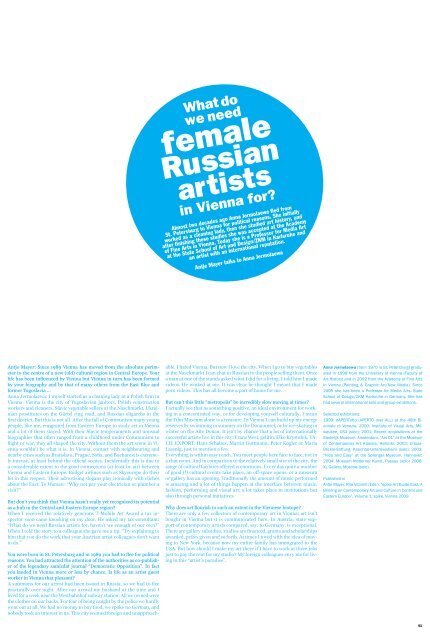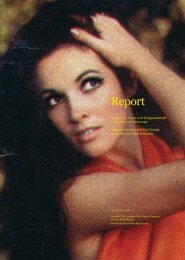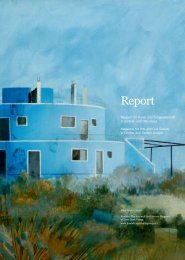Report_Issue 1/2009 - Jubiläum/ 20 Jahre Mauerfall
Report_Issue 1/2009 - Jubiläum/ 20 Jahre Mauerfall
Report_Issue 1/2009 - Jubiläum/ 20 Jahre Mauerfall
Sie wollen auch ein ePaper? Erhöhen Sie die Reichweite Ihrer Titel.
YUMPU macht aus Druck-PDFs automatisch weboptimierte ePaper, die Google liebt.
Antje Mayer: Since 1989 Vienna has moved from the absolute perimeter<br />
to the centre of a new (old) cultural region in Central Europe. Your<br />
life has been influenced by Vienna but Vienna in turn has been formed<br />
by your biography and by that of many others from the East Bloc and<br />
former Yugoslavia …<br />
Anna Jermolaewa: I myself started as a cleaning lady in a Polish firm in<br />
Vienna. Vienna is the city of Yugoslavian janitors, Polish construction<br />
workers and cleaners, Slavic vegetable sellers at the Naschmarkt, Ukrainian<br />
prostitutes on the Gürtel ring road, and Russian oligarchs in the<br />
first district. But this is not all. After the fall of Communism many young<br />
people, like me, emigrated from Eastern Europe to study art in Vienna<br />
and a lot of them stayed. With their Slavic temperaments and unusual<br />
biographies that often ranged from a childhood under Communism to<br />
flight or war, they all shaped the city. Without them the art scene in Vienna<br />
wouldn’t be what it is. In Vienna, contact with neighbouring and<br />
nearby cities such as Bratislava, Prague, Sofia, and Bucharest is extremely<br />
intense, at least behind the official scenes. Incidentally this is due to<br />
a considerable extent to the good connections (at least by air) between<br />
Vienna and Eastern Europe. Budget airlines such as Skyeurope do their<br />
bit in this respect. Their advertising slogans play ironically with clichés<br />
about the East: To Warsaw: “Why not pay your electrician or plumber a<br />
visit?”<br />
But don’t you think that Vienna hasn’t really yet recognized its potential<br />
as a hub in the Central and Eastern Europe region?<br />
When I received the relatively generous T-Mobile Art Award a tax inspector<br />
soon came knocking on my door. He asked my tax consultant:<br />
“What do we need Russian artists for, haven’t we enough of our own?”<br />
When I told the story to a colleague she gave me a tip. “Try explaining to<br />
him that you do the work that your Austrian artist colleagues don’t want<br />
to do.”<br />
You were born in St. Petersburg and in 1989 you had to flee for political<br />
reasons. You had attracted the attention of the authorities as co-publisher<br />
of the legendary samizdat journal “Democratic Opposition”. In fact<br />
you landed in Vienna more or less by chance. Is life as an artist guest<br />
worker in Vienna that pleasant?<br />
A summons for our arrest had been issued in Russia, so we had to flee<br />
practically over night. After our arrival my husband at the time and I<br />
lived for a week near the Westbahnhof railway station. All we owned were<br />
the clothes on our backs. For fear of being caught by the police we hardly<br />
went out at all. We had no money to buy food, we spoke no German, and<br />
nobody took an interest in us. This city seemed foreign and unapproach-<br />
Almost two decades ago Anna Jermolaewa fled from<br />
St. Petersburg to Vienna for political reasons. She initially<br />
worked as a cleaning lady, then she studied art history, and<br />
after finishing these studies she was accepted at the Academy<br />
of Fine Arts in Vienna. Today she is a Professor for Media Art<br />
at the State School of Art and Design/ZKM in Karlsruhe and<br />
an artist with an international reputation.<br />
Antje Mayer talks to Anna Jermolaewa<br />
able. I hated Vienna. But now I love the city. When I go to buy vegetables<br />
at the Naschmarkt I can chat in Russian to the people selling them. Once<br />
a man at one of the stands asked what I did for a living. I told him I made<br />
videos. He winked at me. It was clear he thought I meant that I made<br />
porn videos. This has all become a part of home for me.<br />
But can’t this little “metropolis” be incredibly slow moving at times?<br />
I actually see that as something positive, an ideal environment for working<br />
in a concentrated way, or for developing yourself culturally. I mean<br />
the Film Museum alone is a treasure. In Vienna I can build up my energy<br />
reserves by swimming in summer on the Donauinsel, or by ice-skating in<br />
winter on the Alte Donau. It isn’t by chance that a lot of internationally<br />
successful artists live in this city: Franz West, gelitin, Elke Krystufek, VA-<br />
LIE EXPORT, Hans Schabus, Martin Guttmann, Peter Kogler or Maria<br />
Lassnig, just to mention a few.<br />
Everything is within easy reach. You meet people here face to face, not in<br />
a chat room. And in comparison to the relatively small size of the city, the<br />
range of cultural facilities offered is enormous. Every day quite a number<br />
of good (!) cultural events take place, an off-space opens, or a museum<br />
or gallery has an opening. Traditionally the amount of music performed<br />
is amazing and a lot of things happen at the interface between music,<br />
fashion, performing and visual art; a lot takes place in institutions but<br />
also through personal initiatives.<br />
Why does art flourish to such an extent in the Viennese biotope?<br />
There are only a few collectors of contemporary art in Vienna; art isn’t<br />
bought in Vienna but it is communicated here. In Austria, state support<br />
of contemporary artists compared, say, to Germany, is exceptional.<br />
There are gallery subsidies, studios are financed, grants and scholarships<br />
awarded, prizes given and so forth. At times I toyed with the idea of moving<br />
to New York, because now my entire family has immigrated to the<br />
USA. But how should I make my art there if I have to work at three jobs<br />
just to pay the rent for my studio? My foreign colleagues envy me for living<br />
in this “artist’s paradise”.<br />
Anna Jermolaewa (born 1970 in St. Petersburg) graduated<br />
in 1998 from the University of Vienna (Faculty of<br />
Art History) and in <strong>20</strong>02 from the Academy of Fine Arts<br />
in Vienna (Painting & Graphic Art/New Media). Since<br />
<strong>20</strong>05 she has been a Professor for Media Arts, State<br />
School of Design/ZKM Karlsruhe in Germany. She has<br />
had several international solo and group exhibitions.<br />
Selected exhibitions:<br />
1999: dAPERTutto (APERTO over ALL) at the 48th Biennale<br />
di Venezia. <strong>20</strong>00: Institute of Visual Arts, Milwaukee,<br />
USA (solo); <strong>20</strong>01: Recent acquisitions at the<br />
Stedelijk Museum, Amsterdam; “Ars 01” at the Museum<br />
of Contemporary Art Kiasma, Helsinki; <strong>20</strong>02: Ursula-<br />
Blickle-Stiftung, Kraichtal-Unteröwisheim (solo); <strong>20</strong>03:<br />
“Nice and Easy” at the Sprengel Museum, Hannover;<br />
<strong>20</strong>04: Museum Moderner Kunst, Passau (solo) <strong>20</strong>08:<br />
XL Gallery, Moscow (solo).<br />
Published in<br />
Antje Mayer, Rita Vitorelli (Eds.): “spike Art Guide East. A<br />
Briefing on Contemporary Art and Culture in Central and<br />
Eastern Europe”, Volume 1, spike, Vienna <strong><strong>20</strong>09</strong><br />
41




